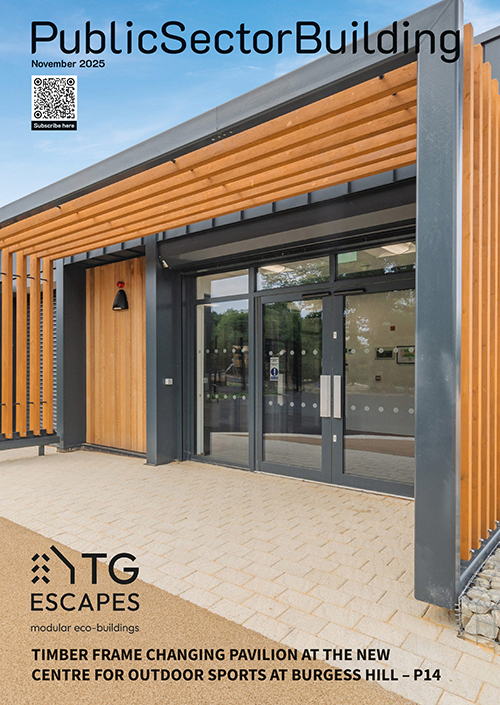Improving indoor air quality can not only reduce transmission of COVID-19 and other airborne diseases, but also improve public health for the long-term. By using data loggers to monitor the indoor environment, building owners, facilities managers and occupants can take an informed approach to balancing good air quality with occupant comfort, explains Tinytag…
The state of indoor air quality in the UK – and its effects on our health – has come under new scrutiny due to the airborne spread of coronavirus in poorly ventilated indoor spaces.
However, many institutions, including the Chartered Institution of Building Services Engineers (CIBSE, UK), the Scientific Pandemic Insight Group on Behaviours (SPI-B, UK) and the Building Engineering Services Association (BESA, UK), are anxious that management of indoor air quality should continue beyond the pandemic. This is due to the significant impact of indoor air quality on our overall health.

Poor indoor air quality, aside from encouraging the spread of contagious diseases, has been linked to respiratory illnesses (such as asthma and cancers), Alzheimer’s disease, heart disease and inflammatory conditions. Considering that people in the UK spend up to 90% of their time indoors, it is undeniable that indoor air quality is affecting our health.
Monitoring the indoor environment effectively provides the first step to improving indoor air quality and promoting long-term public health.
Indoor air quality monitoring: where to begin?
Indoor air pollutants include particulate matter, carbon monoxide, carbon dioxide, radon, volatile organic compounds (VOCs), mould and humidity.
Monitoring for many of these pollutants can be costly and impractical; however, cost-effective and accessible monitoring options are available for measuring CO2.
Carbon dioxide, while naturally present in the air, also builds up in occupied spaces due to occupant respiration. If levels of CO2 are consistently high in an occupied space, it suggests that there is an inadequate supply of fresh air and that indoor air quality is poor.
An understanding of CO2 levels in an indoor space can therefore inform strategies to improve air quality (e.g. increasing ventilation rates).
Methods for improving air quality, however, such as ventilating through natural or mechanical means, can adversely affect indoor temperature and humidity levels, both of which are important for indoor comfort.
Unexpectedly low levels of temperature and humidity can also reveal instances of energy loss resulting from increased ventilation rates. Any attempts to improve indoor air quality must therefore consider and balance the implications for occupant comfort and energy costs.
Monitoring CO2, followed by temperature and humidity, is a simple, cost-effective way to begin building an adaptable indoor air quality strategy that also prioritises and improves occupant comfort and saves energy.
CO2 data loggers: visualising air quality
One obstacle in IAQ management is that air quality is not visible. While building occupants easily recognise uncomfortable temperatures, indoor air quality is difficult to detect by sensation alone.
CO2 monitoring is a simple means of making the indoor air visible. Using carbon dioxide data loggers, building owners and managers can ‘see’ the levels of CO2 in the environment. Identifying consistent levels of CO2 below 800ppm in an indoor space, for example, will indicate that the space is well ventilated. An average of over 1500ppm for the occupied period, on the other hand, indicates that the space is receiving inadequate ventilation.
How to use CO2 data loggers to measure indoor air quality
CO2 data loggers should be placed at head height and away from windows, doors and vents. A sampling location that is representative of overall conditions should be chosen. If CO2 levels are extremely low or high, this may indicate that your data logger is in an unsuitable location. It is good practice to sample CO2 measurements in different areas so that a sufficiently representative monitoring location is used.
Using data loggers with non-dispersive infrared (NDIR) sensors is recommended, as these sensors directly measure the volume of CO2 in the air. It is also recommended that the device has an accuracy of +/- 50ppm and is routinely calibrated. Alarms or other visual indicators of excess CO2 levels are helpful for enabling occupants to improve ventilation when necessary.
After an initial monitoring period, data should be assessed to understand patterns in indoor air quality: for example, whether CO2 levels are elevated at a particular time of day, or whether levels are consistently above the recommended limits. Targeted action can then be taken based on this data.
Efficacy of ventilation strategies
Data loggers should also be used to assess the efficacy of ventilation strategies. Data from continuous monitoring of CO2 levels can be used to justify investment in mechanical solutions for ventilation in areas where natural ventilation is shown to be ineffective, or where natural ventilation should not be utilised due to high levels of outdoor pollution.
Long-term indoor air quality monitoring with CO2 data loggers can ensure consistent efforts are taken to improve indoor air quality on a daily basis and for the future. Occupants can make use of alarm indications by opening windows or vents, or alerting building managers of the need for increased mechanical ventilation. Long-term data can be used to assess environmental patterns, such as seasonal variations in ventilation rates and IAQ, enabling pre-emptive action to be taken to improve indoor air quality.
Balancing ventilation with occupant comfort: temperature and humidity monitoring
Striking a balance between good air quality and good comfort levels should be at the centre of any indoor air quality strategy.
Temperature and humidity both have significant impacts on occupant comfort and well-being — and both are adversely affected by increased ventilation. Uncomfortable temperatures affect concentration, productivity and cause general discomfort. Low humidity, which can occur when ventilation and/or heating dry out the surrounding air, can provoke skin symptoms, nasal dryness and congestion. Excess humidity, meanwhile, encourages the production of dust mites and mould, leading to respiratory problems.
Dual channel data loggers that measure both temperature and relative humidity can be used to simultaneously measure both parameters. Like CO2 data loggers, these should be placed away from openings, such as windows and doors (where draughts can affect the accuracy of readings), and in a location that is representative of overall conditions.
The data can be compared and contrasted with data gathered from CO2 monitoring to identify correlation (or lack thereof) between ventilation rates and temperature and humidity levels.
Results from concurrent CO2, temperature and humidity monitoring can then be used to inform a well-rounded ventilation strategy that prioritises air quality and comfort. Suitable strategies could include regularly ventilating rooms between periods of occupancy so that occupants are less affected by changes in ambient conditions. Any strategies that are implemented should be evaluated with further monitoring to determine their efficacy.
Save energy, save money: monitor for energy efficiency
At a time when energy efficiency is paramount to cutting carbon emissions, it is important that increasing ventilation rates do not contribute to greater energy usage and energy loss.
Reports recommend that ventilation rates should be balanced against the extra energy demands resulting from increased ventilation. Extra energy, for example, may be required to heat and/or humidify a space if increased ventilation causes heat loss or dries out the air. Monitoring temperature, humidity and CO2 can help to save energy by informing the use of ventilation only when necessary and only for an appropriate duration.
CO2 data loggers with alarms are particularly useful, as these can prompt occupants to ventilate only when extra ventilation is required. A long-term understanding of CO2 levels, meanwhile, enables facilities managers to supply ventilation to indoor spaces at a rate that is appropriate to the time of day or season.
Temperature and relative humidity data loggers can be used to assess heat transfer rates and understand how humidity levels correlate with ventilation. When compared with CO2 data, building managers can prevent excess heat and humidity loss by ensuring that ventilation occurs only for the time it takes to ensure effective replacement of the air.
Start monitoring indoor air quality today
The report from the Environmental Modelling Group and SPI-B anticipates that wider uptake of CO2 monitoring, combined with public health campaigns and appropriate workplace training, could improve people’s awareness of the importance of indoor air quality. This, in turn, would lead to improvements in how indoor air quality is managed and how new buildings and retrofits are designed.
Indoor air quality monitoring with data loggers is both simple and cost-effective. USB-connection data loggers are easy to set up and use, and can be moved between locations
and rooms to monitor where necessary. New data loggers can easily be incorporated into an indoor air quality monitoring strategy on an ad hoc basis, making the initial cost of investment flexible to different budgets.
The Tinytag range of data loggers offers options for monitoring temperature, relative humidity and carbon dioxide. Using Tinytag data logging software, data from CO2 data loggers can be overlaid and compared with data from temperature and relative humidity data loggers, enabling effective analysis of indoor air quality in combination with occupant comfort. Outdoor temperature and relative humidity data loggers are also available for assessing how the indoor environment responds to outdoor environmental conditions.




